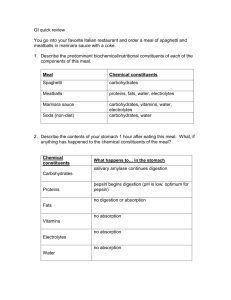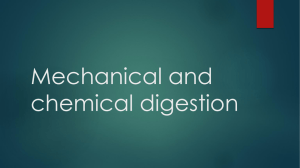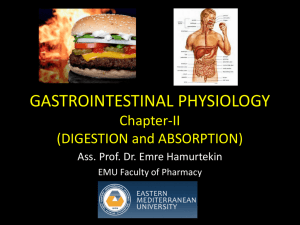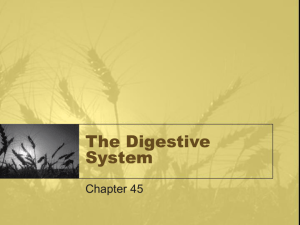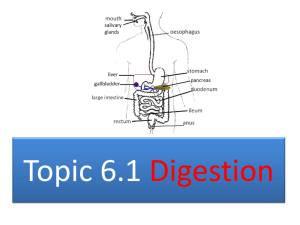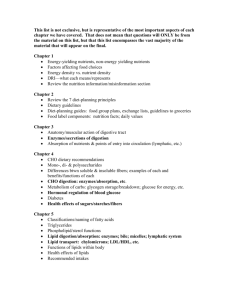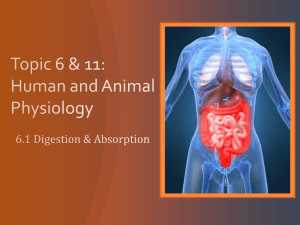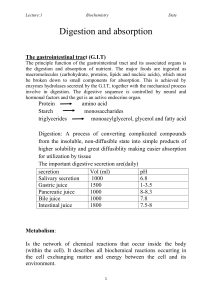Harvard-MIT Division of Health Sciences and Technology HST.121: Gastroenterology, Fall 2005
advertisement
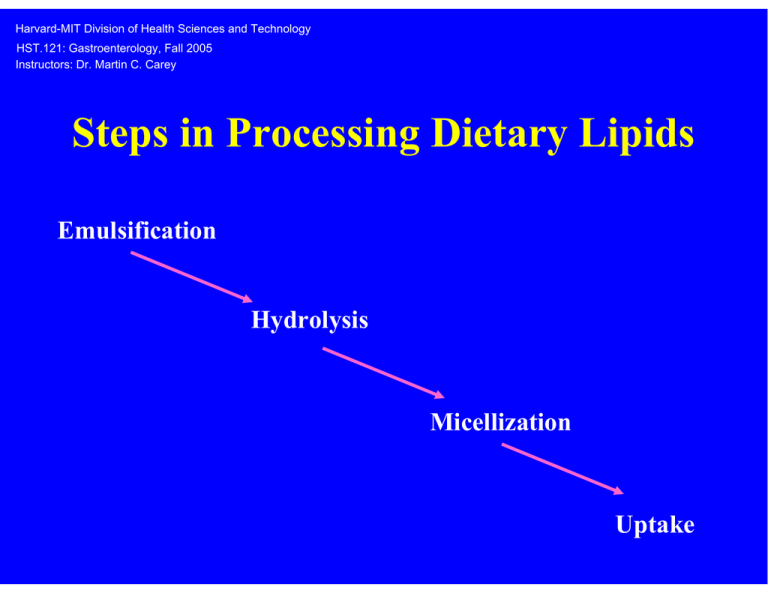
Harvard-MIT Division of Health Sciences and Technology HST.121: Gastroenterology, Fall 2005 Instructors: Dr. Martin C. Carey Steps in Processing Dietary Lipids Emulsification Hydrolysis Micellization Uptake Absorption Efficiency of Dietary Lipids Culinary Emulsification (100%) Hydrolysis (84%) Oro-Pharyngeal Gastric Duodenal Stomach/Duodenum (HGL) Duodenum (HPL) 18% Duodenum (BAL) 10% Micellization (100%) Uptake (99%) 56% Adapted from: Figure 2 in Borgstrom, B., et al. "Studies of Intestinal Digestion and Absorption in the Human." J Clin Invest 36 (1957): 1525. Adapted from: Figure 2 in Borgstrom, B., et al. "Studies of Intestinal Digestion and Absorption in the Human." J Clin Invest 36 (1957): 1525. Adapted from: Figure 2 in Borgstrom, B., et al. "Studies of Intestinal Digestion and Absorption in the Human." J Clin Invest 36 (1957): 1525. Figure removed due to copyright reasons. Please see: Claude Bernard's Memoire sur le Pancreas, Bailliére, Paris, 1856, color plate No. 7-8. PHYSICAL STATES OF MAJOR DIETARY LIPIDS Figure removed due to copyright reasons. Please see: Figure 1 in Carey, M. C., D. M. Small, and C. M. Bliss. "Lipid Digestion and Absorption." Annual Review of Physiology 45 (1983): 651-677. For Effective Hydrolysis… Dietary fats must be dispersed as stable emulsion particles DISPERSED STATES OF MAJOR DIETRY LIPIDS IN WATER Figure by MIT OCW. Humans: Luminal Triglyceride Lipases •Gastric Lipase (chief cells) •Bile Salt-Activated Lipase (breast, pancreas) •Colipase-Dependent Lipase (pancreas) HORMONAL COORDINATION OF THE DIGESTIVE SEQUENCE : PYLORUS - DUODENUM 1. FA(NOT TG) and Acid (HCl) stimulate the release of CCK and secretin respectively. 2. Secretin HCO3 - Rich fluid from the Pancreas, Biliary tree and Brunner's glands. Inhibition of gastric and duodenal motility, contracts pylorus. Potentiates CCK. 3. CCK Strong stimulant of enzyme secretion by the pancreas. Contracts gallbladder and pylorus, stimulates intestinal motility, inhibits ODDI's sphincter. Induces satiety? 4. VIP GIP 2o 2o Vagal activity ? Physiological role Fat in duodenum Result: Digestive millieu (pH, [lipid], [enzymes]) maintained relatively constant. Image courtesy of Dr. James Toouli. Used with permission. Non-catalytic C terminus Catalytic N terminus Figure removed due to copyright reason. Please see: van Tilbeurgh H., et al. "Structure of the pancreatic lipase-procolipase complex." Nature 359 (1992): 159-62. van Tilbeurgh H., et al. "Interfacial activation of the lipase-procolipase complex by mixed micelles revealed by X-ray crystallography." Nature 362 (1993): 814-20. Interfacial activation Figure removed due to copyright reason. Please see: van Tilbeurgh H., et al. "Structure of the pancreatic lipase-procolipase complex." Nature 359 (1992): 159-62. van Tilbeurgh H. et al. "Interfacial activation of the lipase-procolipase complex by mixed micelles revealed by X-ray crystallography." Nature 362 (1993): 814-20. Figure removed due to copyright reason. Please see: Figure 6 in Wang, X., et al. "The crystal structure of bovine bile salt activated lipase: insights into the bile salt activation mechanism." Structure 5 (1997): 1209-18 PHYSICAL - CHEMISTRY OF FAT DIGESTION Figure removed due to copyright reasons. Please see: Figure 11 in Hernell, O., et al. "Physical-chemical behavior of dietary and biliary lipids during intestinal digestion and absorption. 2. Phase analysis and aggregation states of luminal lipids during duodenal fat digestion in healthy adult human beings." Biochemistry 29 (1990): 2041-2056. Figure removed due to copyright reasons. Please see: Figure 1 in Lammert, F., and David Q.-H. Wang. "New Insights Into the Genetic Regulation of Intestinal Cholesterol Absorption." Gastroenterology 129 (2005): 718-34. Classification of Malabsorption Syndromes • Faulty Digestion (Intraluminal) • Faulty Dispersion (Intraluminal) • Faulty Absorption (Mucosal) • Faulty Transport (Lamina Propria, Lymphatics) Work-up of Fat Malabsorption • Suspect • Prove presence of malabsorption: Steatorrhea • Distinguish faulty digestion/dispersion from faulty absorption/transport • Confirm specific diagnosis • Initiate specific treatment Hormonal Control of Appetite and Weight (I) Rapidly acting (via vagal afferents to the arcuate and other nuclei of hypothalamus) a) GHRELIN: from gastric endocrine cells when stomach is empty; stimulates appetite b) CHOLECYSTOKININ (CCK): from endocrine cells in duodenum-jejunum; promotes satiety Hormonal Control of Appetite and Weight (II) Long-term regulators (via blood to specific cells in hypothalmus, generally in proportion to body fat, and exerting sustained inhibitive effects on food intake while increasing energy expenditure) a) INSULIN: from β-cells of pancreas; augmented by VIP and in proportion to dietary intake of fat and sugars; b) LEPTIN: from adipocytes in proportion to body stores of fat; c) PYY3-36: from Neuropeptide Y endocrine cells in distal ileum and colon; blood levels increase several hours after ingestion of a meal.

